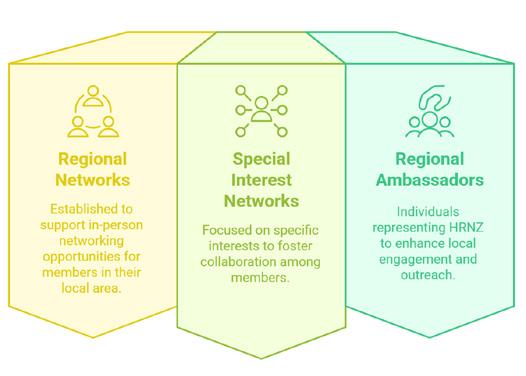
7 minute read
HRNZ constitution changes
HRNZ is in the process of changing its constitution. While not the most thrilling topic, the Constitution is important and shapes the way HRNZ works. HRNZ Project Manager Nadine Tarsa outlines what you need to know.
Did you know that the longest written constitution of any country in the world is the Constitution of India? With a huge 146,385 words, comprising 395 Articles, 8 Schedules and 22 Parts, it took nearly three years to create, from the formation of a Constitutional Assembly to the Constitution being signed and accepted. In comparison, HRNZ’s new proposed constitution only has 10,489 words. Short and sweet. And if you’re interested in how HRNZ is looking to work in the future, you should give it a read.
WHAT IS A CONSTITUTION?
The word ‘constitution’ can be used in many different ways, but the best explanation for HRNZ’s constitution is a written instrument that embodies the rules of a political or social organisation.
A constitution is a legal requirement for all incorporated societies. It is essential because it outlines the society’s purpose, what it does and how it operates. It provides a framework for the society’s activities, ensuring transparency, consistency and accountability, and can help in resolving conflicts. As quoted by the New Zealand Companies Office:
“Your society can only carry out lawful activities that align with the purposes outlined in its constitution. Your officers, committee and members should always refer to this document for guidance on running your society, particularly before making any decisions.”
So it is essential that the constitution clearly reflects what HRNZ does.
WHY IS HRNZ CHANGING ITS CONSTITUTION?
In 2023 the Incorporated Societies Act 2022 replaced the Incorporated Societies Act 1908, modernising the legal, governance and accountability framework for the country’s more than 23,000 incorporated societies.
Here’s what the Act said about why it needed to change:
“The 1908 Act had become outdated, lacking clarity on governance, officers’ duties, dispute resolution and financial reporting. The 2022 Act addresses these gaps, codifies best practices, and aligns society governance with contemporary expectations.”
All existing societies must reregister under the new Act by 5 April 2026 or risk being removed from the register and losing their legal status. To re-register, every society must prepare a new constitution that complies with the 2022 Act.
Process So Far
HRNZ was ahead of the game with many of the legislative changes. It already complies with many updates, such as financial reporting, holding an annual general meeting, having a governing body with at least three members (thanks to our Board) and having a dedicated contact person for the Registrar of the Incorporated Societies to get in touch with. If you’re interested, a list of all the legislative changes required can be found on the Incorporated Societies website here
One of the significant legislative changes for HRNZ is the addition of a disputes resolution process, which has now been added to its constitution.
As a result of the legislative changes, the Chief Executive Nick McKissack and the HRNZ Board wanted to review HRNZ’s constitution as a whole, to better reflect the way HRNZ currently operates and modernise the way the organisation works in the future. This has involved reviewing the way we interact with each other, in particular the networking channels. As a result, the Constitution now includes three networking channels:
• Regional Networks
• Special Interest Networks
• Regional Ambassadors.

Regional Networks are like branches. These will continue to be run by the same committees, with a slight name change from president and vice-president to chair and vice-chair. The main focus for Regional Networks will be on kanohi ki te kanohi (face-to-face) events. They will continue to provide in-person networking opportunities in the local area and promote HRNZ objectives and services.
Special Interest Networks will be created by members who have an interest in a specific area. Similar to the Regional Networks, most will be run by a special interest committee with a chair and vice-chair. A few Special Interest Networks may be run by an HRNZ employee, such as the popular Tech Channel. The main focus for Special Interest Networks will be to support knowledge sharing and networking around their particular interest. These will be nationwide, so most events will be held online.
HRNZ already has a few Special Interest Networks, such as the Academic Branch, the Tech Channel, and Rōpū. More
Special Interest Networks are already in the pipeline, so keep an eye on this area for future growth. If you have any ideas for a Special Interest Network and would like to be involved in setting one up, please contact networks@hrnz.org.nz.
Regional Ambassadors are a new concept for HRNZ. Instead of a committee, a person (called a Regional Ambassador) can be appointed in an area to represent HRNZ in kanohi ki te kanohi events. Their focus will be on enhancing local engagement, primarily through the Café Connects, and promoting HRNZ services. Regional Ambassadors may be appointed in an area where a substantial amount of HRNZ members reside, but a Regional Network is unable to reach geographically (think Gisborne in the Hawke’s Bay region or Greymouth in the Canterbury region). It could also be a great way to encourage membership and participation, potentially leading to the establishment of a Regional Network in areas that don’t currently have an active network.
Feedback
HRNZ held a webinar in March 2025 regarding the proposed changes to the Constitution. The organisation also emailed all members asking for questions or feedback, and included an item in the Quarterly Report regarding the changes to the Constitution, requesting feedback. The feedback received from members has been very positive.
The Board has officially approved the proposed new constitution. Members approved the constitution at the annual general meeting held on 22 August 2025. Now, HRNZ can re-register as an Incorporated Society under the 2022 Act.
WHAT DOES THIS MEAN FOR HRNZ MEMBERS?
Members will continue to be part of the Regional Network closest to them. All new members will be automatically assigned to a Regional Network.
Members will be able to join as many Special Interest Networks as they want. People will be able to opt in and out of these themselves.
Special Interest Networks will also allow members to tailor the events and information they receive from HRNZ to suit their individual HR needs.
If members live in an area with a Regional Ambassador, they may be invited to attend local events. Not all areas will have Regional Ambassadors; these will be appointed on a caseby-case basis.
These three different ways of networking are intended to increase engagement, especially for in-person events, which is an integral part of what makes HRNZ a unique and successful organisation. As a member said in the webinar about changes to the Constitution, “the connections and in-person events are the value of HRNZ”.
Next Steps
HRNZ is now working through all the system and process changes necessary to comply with the new Constitution. Any changes will be communicated to all members.
Once completed, HRNZ will re-register before the April 2026 deadline.
Then HRNZ can get started on creating new networks that encourage information sharing, networking and collaboration, benefitting all members.
The HRNZ Constitution is available to read here.
Nadine Tarsa joined HRNZ as a project manager in November 2024 to work on implementing the changes to HRNZ’s new constitution. She has a background in service delivery, CRM improvements and governance of membership organisations.










